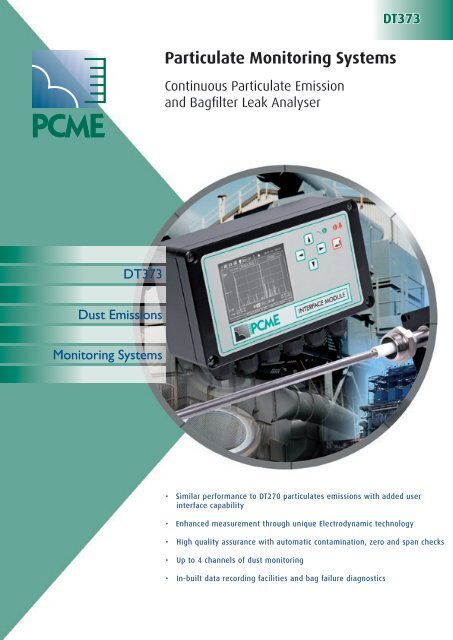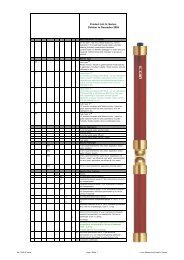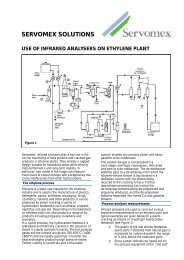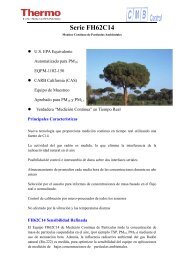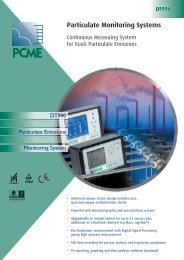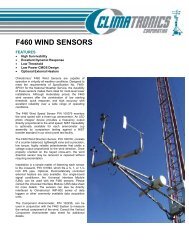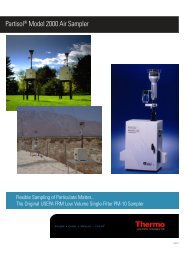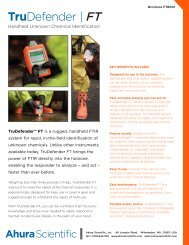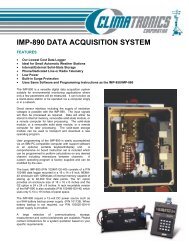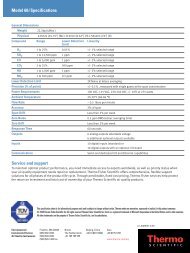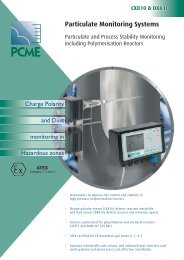DT373 Particulate Monitoring Systems - CMB Control
DT373 Particulate Monitoring Systems - CMB Control
DT373 Particulate Monitoring Systems - CMB Control
You also want an ePaper? Increase the reach of your titles
YUMPU automatically turns print PDFs into web optimized ePapers that Google loves.
<strong>Particulate</strong> <strong>Monitoring</strong> <strong>Systems</strong>Continuous <strong>Particulate</strong> Emissionand Bagfilter Leak Analyser<strong>DT373</strong><strong>DT373</strong>Dust Emissions<strong>Monitoring</strong> <strong>Systems</strong>• Similar performance to DT270 particulates emissions with added userinterface capability• Enhanced measurement through unique Electrodynamic technology• High quality assurance with automatic contamination, zero and span checks• Up to 4 channels of dust monitoring• In-built data recording facilities and bag failure diagnostics
technologyPrinciples of OperationThe DT370 series instruments utilise PCME’s unique Electrodynamic measurement principle.When the sensing probe is installed in the duct or stack, particles in the air stream interactwith the sensing rod and a charge induction effect is analysed from the probe. Distributionsin the particle stream result in a frequency charge induction response which is proportionalto the concentration of particles (application dependent). 1 Unlike triboelectric systems,Electrodynamic systems electronically filter out the dc signal caused by particle collision,which makes the quality of the measurement unaffected by build-up on the probe whichwould otherwise cause zero or calibration drift. Very low concentrations of particulate foundafter even the most efficient bag filter can be measured due to this unique Electrodynamictechnique.1 Various independent laboratories have validated this relationship.SensorTo control unitStackElectrodynamic technology also enables the use of patented fully insulated probes, essentialfor reliable measurement in high humidity applications (after process and spray driers) and applications with high conductive dust loadings.Modes of OperationThe DT370 series instruments are particularly suited for monitoring particulate emissions from industrial applications controlled with bagfilter-typearrestment plant having rugged performance and sufficient resolution for these applications. The instrument’s output is directly proportional to particulateand may be used to monitor emission tendencies or calibrated in mg/m3 by comparison to the results of an Iso-kinetic (gravimetric) sample. Theinstrument has in-built data recording and graphics display capability enabling emission trends to be easily viewed and plant data can be averaged andrecorded in the instrument for alarm purposes and external emissions reporting (via optional DustReporter 2).All DT370 type instruments have an in-built alarm log which ensures all alarm conditions (emission events, self-check results, instrument failure) are properlystored for reporting purposes and have a separate user defined data log which may be set-up to record data for one of the following purposes:Broken bag mode (pulse log)• Short term emission pulses arising from bag cleaningcan be recorded and analysed (2 hours of pulse datato cover multiple cleaning cycle)• Permits anticipation of arrestment plant failure• Assists location of broken bagsEmissions reporting mode (long term log)• Calculates and stores emission averages for up to600 days (@ 15 min average)• DustReporter 2 PC software used for data archivingand external reportingProcess control mode (short term log)• Stores instantaneous or•short term averagedata for past 24 hoursEmissions can bereviewed on instrumentfor effective35.0030.0025.0020.0015.00trend analysis<strong>Particulate</strong> level mg/m 310.005.000.00EPA REPORT<strong>Particulate</strong> Emissions fromDust Arrestment Plant in mg/m 314 Dec 15 Dec 16 Dec 17 Dec 18 Dec 19 Dec 20 Dec 21 DecDay/Year 1994(DD Mth)Dust Dust Level Level110100908070605040302010011:08%BROKEN BAG MODE11:10 11:12 11:14 11:16 11:183 Cleaning Cycles of filterAutomatic self-checks<strong>DT373</strong>: is provided with an Insulator Short circuit test, an internal diagnostics check which hourly monitorsfor a change in resistance in the insulator at the base of the sensor rod. While the sensing rod is tolerantto dust contamination (due to Electrodynamic performance), it is important that the insulator remains fullyoperational. While this check rarely fails, since the insulator is not directly in the particle flow, it providesa fail-safe method of ensuring good Electrodynamic measurement.<strong>DT373</strong>: is also provided with automatic zero and span checks which applysimulated Electrodynamic signals directly at the sensor’s electronic input.This feature is of particular value for regulatory monitoring providing positive feedback that the instrumentoperation is within specifications.The sensor is also provided with an internal coms check to ensure that there is proper digitalcommunication between the control unit and sensor (ensures good cable connection) and that the sensor’smicroprocessor is fully operational.
Features• Expandable to four dust sensors digitally linked to central userinterface module• Quality Assurance features and screens for analysis of self-check results• Alarms (with configurable delay) based on both rolling average dataand instantaneous data for reliable plant failure detection and diagnostics.• Unique graphics display and data logger (for trend analysis)• In-built datalogger for Environmental (600 days), Process control orBroken bag mode• Automatic zero, span, probe contamination and system check options• Auto-ranging and Dynatrack feature (instrument adjusts its dynamicrange to track fast moving dust pulses (typically found after reverse jetbaghouses) to ensure good measurement• Simple calibration mode after iso-kinetic sample• Accepts inputs from analysers for on board normalisation (T,Oxygen, P)• Secure data and password protection• Interlinks to DustReporter 2 reporting and analysis software for on-linecontrol and historical reporting using PCMemory Capacity (user selectable pulse, short term or long term logger)Event LogPulse DataShort-term DataLong-term DataLog for emission events (instantaneous or average emissions), self-checks and instrument alarmsDisplays and records 2 hours of cleaning cyclesRolling 24 hour data at 30 second store rate16,000 data points (eg 600days @ 1hour average). Average period fully adjustable from 30 seconds to 24 hour)FunctionsCalibration Mode (mg/m3)Review of MemoryAccess SecurityData SecurityEmissions DisplayConfiguration and Set-upComputes calibration factors associated with isokinetic test and associated instrument averageGraphics trend or listing display of stored dataPassword level to protect unauthorised entryData stored in non-volatile memory.Multibar and overview screen of emissions on up to 4 channelsOn board screens or PC configuration (config wizard)<strong>Control</strong> unit/AOM unitResolution
specificationsSystem LayoutPhysical DimensionsStandard SensorInsulated SensorHigh Temp SensorPassive SensorProduct Ordering CodesSENSORRODdt373 -SENxxxxP/CCdt373 -RODxxxxS/PtSensor Type: P Standard temperature up to 250 o C.cc Temperature Variants.Material: S Stainless Steel OR P InsulatedSpecify temperature range: 250 o C, 0400 o C, 0800 o C and 1000 o CRod Length: 100-1000mmAbout PCME LtdAs a progressive environmental Company, PCME specialises in particulate measurement for industrial processes. With a worldwide reputation for reliability,innovation and technological excellence, the Company produces equipment for concentration and mass monitoring for regulatory, environmental andprocess control requirements. A dedicated team of qualified application and sales engineers is always on hand and should be consulted in the selectionand usage of the most suitable equipment for any particulate application.PCME LtdClearview Building, 60 Edison RoadSt. Ives, Cambs PE27 3GH UKContact your national or area sales and service officeTel: Int +44 (0)1480 468200Fax: Int +44 (0)1480 463400E-mail: sales@pcme.co.ukIssue 05/06PCME products are the subject of worldwide patents. Due to the continuing product development programme, PCME reserves the right to change anyspecifications without prior notice.


